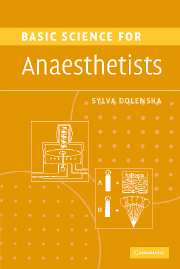Book contents
- Frontmatter
- Contents
- List of abbreviations and symbols
- List of figure captions
- Forewords
- Preface
- Preface to the second edition
- Part 1 Physics, mathematics, statistics, anaesthetic apparatus
- Part 2 Clinical measurement
- Part 3a Physiology: the cardiovascular system
- Part 3b Physiology: the respiratory system
- Part 4 Pharmacology
- 1 Drug elimination
- 2 Uptake and distribution of inhalational anaesthetic agents
- 3 Pharmacodynamic effects of drugs
- 4 Minimum alveolar concentration and lipid solubility
- 5 Receptor types, molecular action of anaesthetics
- 6 Context sensitive half-time
- Further Reading
- Index
6 - Context sensitive half-time
from Part 4 - Pharmacology
Published online by Cambridge University Press: 13 August 2009
- Frontmatter
- Contents
- List of abbreviations and symbols
- List of figure captions
- Forewords
- Preface
- Preface to the second edition
- Part 1 Physics, mathematics, statistics, anaesthetic apparatus
- Part 2 Clinical measurement
- Part 3a Physiology: the cardiovascular system
- Part 3b Physiology: the respiratory system
- Part 4 Pharmacology
- 1 Drug elimination
- 2 Uptake and distribution of inhalational anaesthetic agents
- 3 Pharmacodynamic effects of drugs
- 4 Minimum alveolar concentration and lipid solubility
- 5 Receptor types, molecular action of anaesthetics
- 6 Context sensitive half-time
- Further Reading
- Index
Summary
This concept was developed to describe drug elimination after an intravenous infusion, designed to produce a steady plasma concentration of a drug, is discontinued. Drugs which depend on the liver or kidneys for their elimination demonstrate this phenomenon. In practice, this encompasses all hypnotic drugs and opioids used in total intravenous anaesthesia, with the exception of remifentanil, which is eliminated from the body by tissue and plasma esterases. Half-time is the time required for the drug concentration to halve. Recovery cannot be expected before the plasma concentration decreases below 50% or the clinically effective concentration.
The half-time is context sensitive because drug elimination depends on the duration of infusion. To understand it, consider the three-compartment pharmacological model, consisting of the central compartment-C1-(the intravascular space) and two peripheral compartments, one which equilibrates with the central compartment fairly rapidly-C2-(well perfused tissues such as the brain) and the other which equilibrates more slowly because of poorer perfusion-C3-(fat). The rich or poor perfusion is illustrated in the figures opposite by a wide or narrow band connecting the compartments.
After a short duration infusion, the peripheral compartments have not yet reached equilibrium with the central compartment (see Figure 131). Therefore, after the infusion is discontinued, plasma concentration declines fairly rapidly as the drug continues to redistribute into the peripheral compartments, until equilibrium is reached at a lower plasma concentration. Because redistribution is faster that elimination, context-sensitive half-time in this situation is closer to the redistribution half-life.
Information
- Type
- Chapter
- Information
- Basic Science for Anaesthetists , pp. 186 - 189Publisher: Cambridge University PressPrint publication year: 2006
